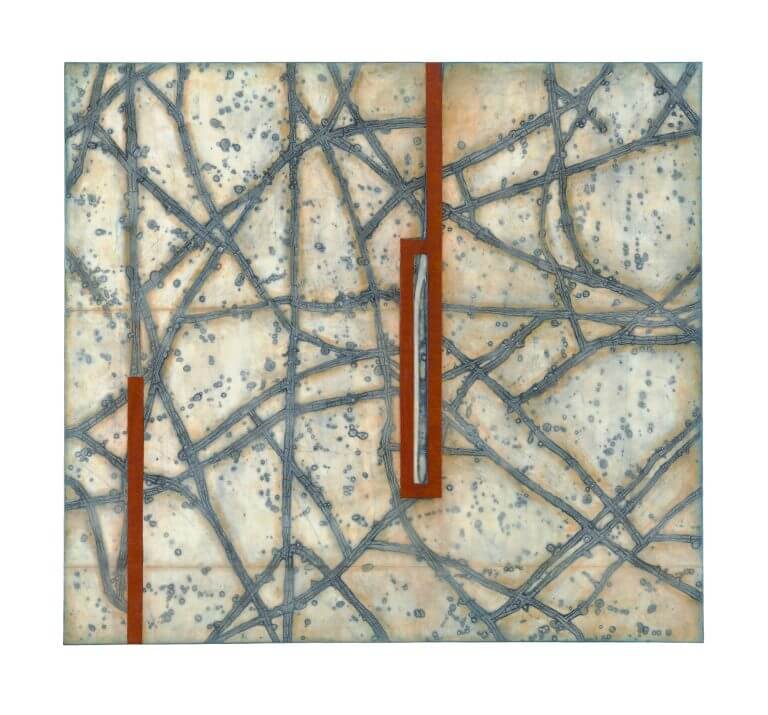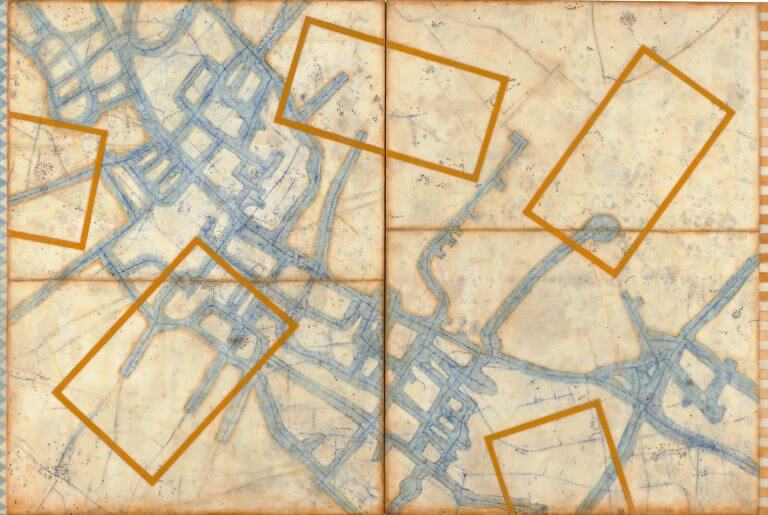In her solo exhibition at the Hunterdon Art Museum, Diana González Gandolfi explores the life experience of being uprooted and moving among various cultures throughout the world. Her paintings and prints featured in Navigated Territories are autobiographical and are part of a series that focuses on memory, identity and place.
González Gandolfi recently took a few minutes to discuss her exhibition.
Q: What will Museum visitors see when viewing your exhibition. Could you talk a little about the show?
A: The paintings and prints in Navigated Territories are part of a series that focuses on the themes of memory, identity and place. The images are full of familial, cultural and political influences and make reference to early remembrances, experiencing new worlds and coexisting among diverse cultures. They metaphorically ex plore issues about separation, alienation, loss, political injustices and mortality.

Diana González Gandolfi, left panel.
In this series, I use map imagery of places I grew up, visited, or lived in as backdrops for personal narratives. Each work maps a psychological and emotional relationship to a place and the memories accumulated. The abstract imagery is symbolically representative of my diverse and layered identity. The works relate to each other like a storyboard yet each individual piece has its own narrative and geography.
The title of each work makes reference to a place, a time and a relationship. The larger works speak conceptually about time and place while the smaller works on paper are more intimate portrayals of specific political situations.
The curators selected 17 pieces for this exhibition mostly of new work, never before exhibited. Their selection includes a grouping of six thematic works (Round-About Series) and several large-scale mixed media multiple panel paintings as well as five printed works on paper.
All of the works in this exhibition are hybrids of drawing, painting and printmaking, and have a printed image as their base. In one-way or another, each incorporates beeswax in their making. The framed paper pieces are either monotypes or encaustic collagraphs that have been reworked with watercolor and color pencil. The works on panel are all mixed media layered works that start as encaustic collagraph or monotype prints. These pieces are then attached to wood panels and reworked with layers of encaustic medium, collage elements, pigmented wax, graphite, watercolor and pigment stick. The finished paintings and prints are each unique, one-of-a-kind works.
Q: Can you tell us about how the title of the exhibition Navigated Territories relates to what the audience will see?
A: I am using the word navigated as a synonym for the word traveling and the word territories to describe a region in which one feels at home. Together these words are symbolic of my personal experiences and metaphorically speak of journeys taken and unexplored places.
The experience of geographic and temporal separation from the place I once called home is central to most of my recent work. I grew up in many countries and many homes and learned early on to make home wherever I found myself in. The works in this series specifically relate to these experiences of being uprooted and in transition, of moving from a known singular place to a layered world where multiple cultures and geographies competed and connected.
Q: Your artist statement mentions that the nature of your work is autobiographical. Does this hold true for this exhibition? If so, how?
A: All of my work is autobiographical, especially the map images I have been making over the past four years. I grew up between multiple cultures and continents, thanks to my father’s job as an architect for the United Nations.
After his death in 2005, I became more interested in exploring my past through my work. Up until then the focus had been mostly on exploring the here and now. Recently, with additional family losses, the interest to work with personal memories has intensified. There has been a shift as well in the context of the work, the emphasis being more on the loss of someone rather than the loss of place.
Q: What do you hope people will get out of your exhibition after viewing it?
A: The works in this exhibition speak of my life’s journey. I use maps metaphorically to represent these journeys. Maps are wonderful vehicles to explore all sorts of things and it is my hope that the viewers will explore not only my journeys but also leave this show with an awakened interest in exploring new paths of their own.
Q: Is there a particular painting that’s going to be on exhibition that you could tell us something about? If you were going to take a group of people into your exhibition and highlight one work, what would it be and what would you say about that piece.
A: The triptych Trinity of Memories is the largest piece in this exhibition and central to the meaning of the entire show. It is a special piece for me and very symbolic of a recent event. It is about connections and navigating difficult moments in life with the assistance and caring of loved ones. It is about transitions and traversing across uncontrollable life situations.
Q: What is it about working in encaustic that appeals to you? Is there anything unique about how you work that might be interesting to share with exhibition viewers?

Diana González Gandolfi, Forgotten But Now Remembered, 1985 Argentina.
A: I have been working with encaustic paints (a mixture of pigment, beeswax and damar resin melted together) as a painting and printmaking medium for almost twenty years. I love everything about working with wax!
Encaustic appeals to me for many of the same reasons that it has appealed to many artists since it first was used as a painting material in the 5th Century B.C. The rich organic nature of the medium is my first attraction to it. The fact that it can be used straight from the source without much processing and without solvents is another. I love how it feels, how it smells, and the effects that can be created with it. The process of applying layers of wax and the process of excavating through layers for meaning and context, is a meditative process I deeply enjoy. I love the rich colors and luminosity achieved when working with transparent layers. I am drawn to it for its three-dimensional characteristics and the ability to incorporate other materials, processes and mediums. Working with this material is an intimate, tactile, emotional and gestural experience for me.
A painter and printmaker throughout my entire artistic career, I learned the techniques of encaustic monoprinting and encaustic collagraph printing fairly recently. The work in this show combines these two processes along with drawing and encaustic painting, creating hybrid works that can be categorize as either paintings or reworked prints. I often call them mixed media works just to keep things simple.
Q: Are you creating art specifically for this exhibition?
A: Most of the work in this show was created or finished for this show but not necessarily created specifically for it. It is work that I would have made regardless. These group of works succeeds my previous series from 2014 called Memory Terrains. Both series make use of personal map imagery to focus on the themes of identity, place and memory. The more recent work at HAM is visually and conceptually more abstract.
Image credit: (Featured Image) Diana González Gandolfi, Trinity of Memories: 2015 NYC (right panel); (second image) left panel. Below: Forgotten But Now Remembered, 1985 Argentina.